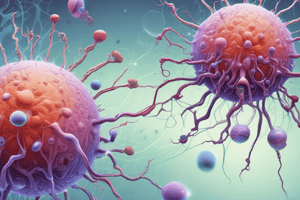Podcast
Questions and Answers
What is the primary focus of the branch of biology known as microbiology?
What is the primary focus of the branch of biology known as microbiology?
- The study of animal biology
- The study of microorganisms (correct)
- The study of plant biology
- The study of macroscopic organisms
What is the primary role of bacteriophages in microbiology?
What is the primary role of bacteriophages in microbiology?
- To decompose organic matter
- To infect and replicate within bacteria (correct)
- To cause diseases in humans
- To ferment food
Bacteriophages are classified based on which characteristics?
Bacteriophages are classified based on which characteristics?
- Shape, size, and other characteristics (correct)
- Shape, size, and genome size
- Morphology, habitat, and restriction patterns
- Genome size, habitat, and other characteristics
What is a potential application of bacteriophages in microbiology?
What is a potential application of bacteriophages in microbiology?
In which context have bacteriophages shown promising results in reducing the presence of bacterial pathogens?
In which context have bacteriophages shown promising results in reducing the presence of bacterial pathogens?
What is the term used to describe the ability of bacteriophages to lyse bacterial cells?
What is the term used to describe the ability of bacteriophages to lyse bacterial cells?
What is the primary advantage of using bacteriophage cocktails over individual bacteriophages?
What is the primary advantage of using bacteriophage cocktails over individual bacteriophages?
What is the primary function of the extracellular polymeric substances (EPS) in biofilms?
What is the primary function of the extracellular polymeric substances (EPS) in biofilms?
Which of the following is a key factor in achieving effective bacterial reduction using bacteriophages?
Which of the following is a key factor in achieving effective bacterial reduction using bacteriophages?
What is the significance of understanding biofilm structure and composition?
What is the significance of understanding biofilm structure and composition?
Which of the following environments is NOT typically associated with biofilm formation?
Which of the following environments is NOT typically associated with biofilm formation?
What is the primary focus of the field of microbiology?
What is the primary focus of the field of microbiology?
Flashcards are hidden until you start studying
Study Notes
Microbiology: An Introduction to the Study of Microorganisms
Microbiology is the branch of biology that deals with the study of microorganisms, including bacteria, archaea, viruses, fungi, protozoa, and other microscopic organisms. These microorganisms play a crucial role in many aspects of life, from decomposing organic matter to fermenting food to causing diseases in humans and other organisms. In this article, we will explore various aspects of microbiology, focusing on bacteriophages and biofilms.
Bacteriophages: Viruses that Infect Bacteria
Bacteriophages, or phages, are viruses that infect and replicate within bacteria. They are an important topic in microbiology due to their potential applications in various fields, such as medicine and biotechnology. Bacteriophages are classified based on their shape, size, and other characteristics. For example, they can be divided into three main classes: Myoviridae, Podoviridae, and Siphoviridae.
Characterization and Lytic Capacity of Bacteriophages
Bacteriophages have been characterized for their morphology, genome size, and restriction patterns. The effectiveness of bacteriophages in reducing the concentration of bacterial pathogens has been studied in various contexts, such as foodborne illness control and poultry colonization reduction. For instance, bacteriophages have shown promising results in reducing the presence of Salmonella in chickens.
Bacteriophage Cocktails and the Significance of Treatment Schedule
Bacteriophage cocktails, which consist of multiple bacteriophages, have been shown to be more effective in promoting the lysis of bacterial cultures than individual bacteriophages. The frequency and timing of bacteriophage treatment have been found to be crucial in achieving effective bacterial reduction over time.
Biofilms: Communities of Microorganisms
Biofilms are complex microbial communities that form on surfaces and consist of microorganisms embedded in a matrix of extracellular polymeric substances (EPS). Biofilms can be found in various environments, including water, soil, and the human body. They are essential for understanding microbial ecology and have implications for public health, as they are involved in the development of infections and the spread of antibiotic resistance.
Formation and Composition of Biofilms
Biofilms are formed through a series of processes, including initial attachment, bacterial adhesion and aggregation, and maturation. The chemical composition of EPS varies between different types of microorganisms, such as Gram-positive and Gram-negative bacteria. Understanding the structure and composition of biofilms is crucial for developing strategies to control their growth and activity.
In conclusion, microbiology is a fascinating field that encompasses the study of various microorganisms, including bacteriophages and biofilms. It is essential for understanding the complex interactions between microorganisms and their environments, as well as for developing strategies to control the spread of infectious diseases and promote the use of beneficial microorganisms in biotechnology.
Studying That Suits You
Use AI to generate personalized quizzes and flashcards to suit your learning preferences.




